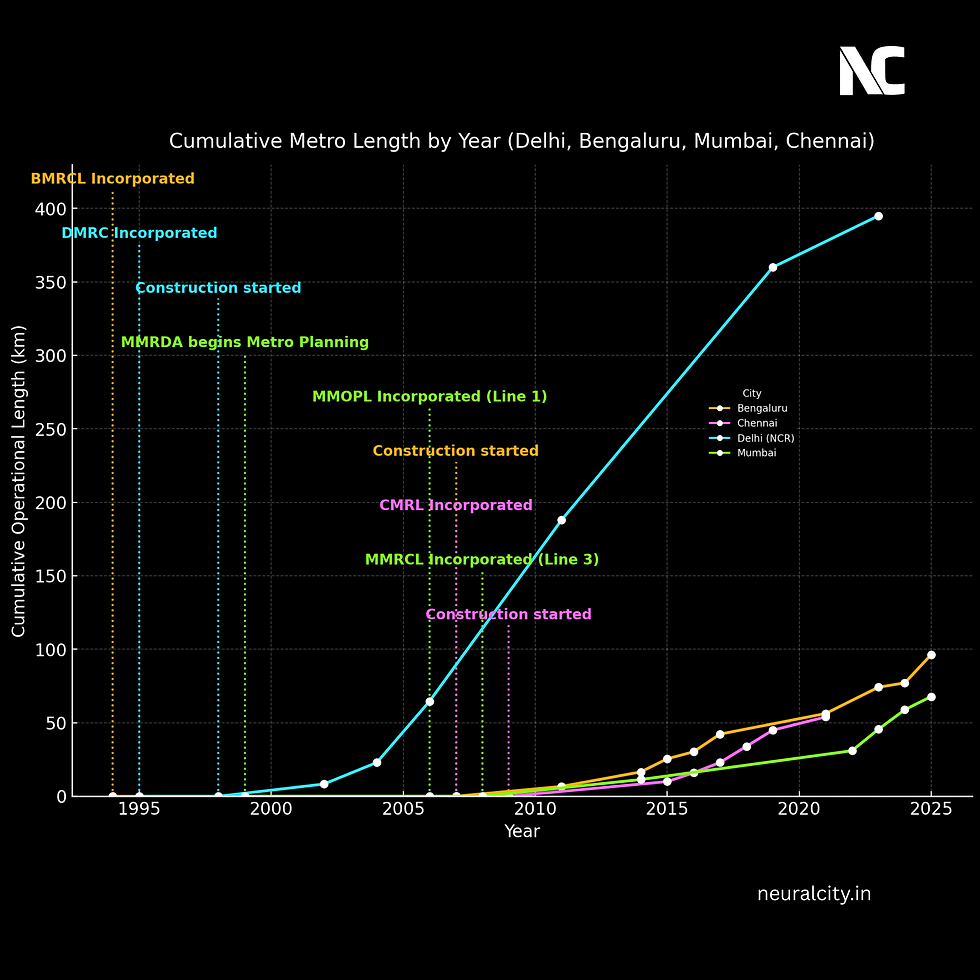Water-logging Is a Network Problem, Not Just a Drain Problem
- Neural City Team

- May 25
- 3 min read
Updated: May 28
Every monsoon, India’s big cities—from Delhi and Mumbai to Bengaluru and Chennai—hit the headlines for all the wrong reasons: submerged streets, stranded commuters, flooded homes.
The public narrative, and too often the official response, zeroes in on a single culprit: “drains not cleaned before rains.”
But the reality is more complex. Urban water-logging is not just about garbage in drains. It’s about the whole chain of urban drainage infrastructure, from the slope of the road itself to the final outfall. If even one link is broken or badly built, the result is the same: water stands where it shouldn’t.
Let’s break down the anatomy of a city’s drainage system—and how its weakest links determine whether your street floods or not.

The Anatomy of City Drainage: What Keeps a City Dry?
1. Road Surface Grade & Slope

Function: Ensures water flows off the carriageway into the drains.
Longitudinal slope (along the length) and cross slope/camber (side to side) both matter. Even a small section of wrongly paved road can pool water.
Common Failure: Patchwork road repair ignores original slope, or new blacktop doesn’t match the required gradient.
2. Side Drains & Gutters

Function: Collect runoff from the road and footpath edges.
Types:
Open drains (common in older or less dense areas)
Covered drains (newer, but if covers aren’t removable, they can’t be cleaned)
Common Failure:
Drains missing in sections;
Broken, buried, or non-existent connections to main network;
Debris and construction waste block the channel.
3. Catchpits / Stormwater Inlets

Function: Grated inlets (called “jalis” in India) at frequent intervals allow rainwater to enter the drainage network.
Common Failure:
Inlets spaced too far apart;
Blocked by silt/leaves;
Road resurfacing buries them;
Placed at the wrong level (above or below the road surface).
4. Culverts / Cross-drains

Function:
Allow water to pass under roads, especially at intersections, natural drains, or where roads cross low-lying land.
Common Failure:
Undersized pipes or blocked culverts;
Encroachment or illegal constructions block water paths.
5. Main Drainage Network

Function:
Large underground pipes or open nallahs (drains) that collect water from all the smaller side drains and carry it out of the neighborhood.
Common Failure:
Bottlenecks at pipe junctions;
Under-capacity (built for population 30 years ago);
Damaged or collapsed pipes;
Cross-connections with sewers cause overflow.
6. Outfalls / Discharge Points

Function:
Where all the city’s stormwater ultimately goes—river, canal, lake, soak pit, or natural depression.
Common Failure:
If outfall is submerged (river in flood), water cannot exit—leading to backflow;
Blockage at the endpoint;
Outfalls encroached or silted up.
How Water-logging Happens: It's a System of Permutations & Combinations
Water-logging is rarely caused by a single failure. Usually, it’s a chain of small issues at multiple points, each amplifying the next. Here’s how things can go wrong:
Scenario 1: Slope Mistake
Road is resurfaced with wrong slope → Water pools at low point
Catchpits are present, but located at the higher end or blocked
Even clean side drains can't help, as water never reaches them
Scenario 2: Broken Drain Chain
Good road slope, catchpits and side drains present
Main drain is undersized or blocked downstream
Water backs up into side drains, then onto the road
Scenario 3: Outfall Blocked
Entire network is fine but the final outfall is underwater due to high river/canal level, or silted up
Water in drains can't exit, rises up through catchpits onto the street
Scenario 4: Missing Link
Side drains built on one stretch, missing or broken in another
Water collects in the "missing" section, can't move further
Scenario 5: Encroachment/Illegal Construction
Open drain or culvert path built over, narrowed or blocked by encroachment (shops, ramps, dumping)
Creates instant chokepoint for entire upstream network
What Should Cities (and Citizens) Do Differently?
Go beyond cleaning: Annual pre-monsoon drain cleaning is not enough. Cities must audit the entire network—road slope, drain continuity, inlet presence, main drain capacity, and outfall condition.
Fix missing or broken links: Map out and close gaps between old and new infrastructure, restore original slopes after resurfacing.
Monitor outfalls: During peak monsoon, have real-time monitoring of river/canal levels to anticipate backflow risk.
Enforce against encroachment: Ensure that drains and culverts are not illegally built over or narrowed.
Public participation: Encourage citizens to report broken inlets, encroached drains, or visible blockages—not just garbage.
Beyond Choked Drains: Why City Water-logging is a System Problem, Not Just a Cleaning Issue
If cities want to beat water-logging, they must look at the drainage network as an integrated system, not a set of isolated parts. Just one “weakest link” in the chain—be it a missing catch-pit, the wrong slope, or a choked outfall—can undo the best efforts elsewhere.
A city that audits, upgrades, and maintains the full drainage network—from road surface to final outfall—will weather the monsoon. Others will be left wading.




The use of dimpled boards with filter fabric keeps channels open and directs water to the drainage system efficiently. Investing in waterproofing early avoids costly excavation and ensures long-term structural stability for buildings.